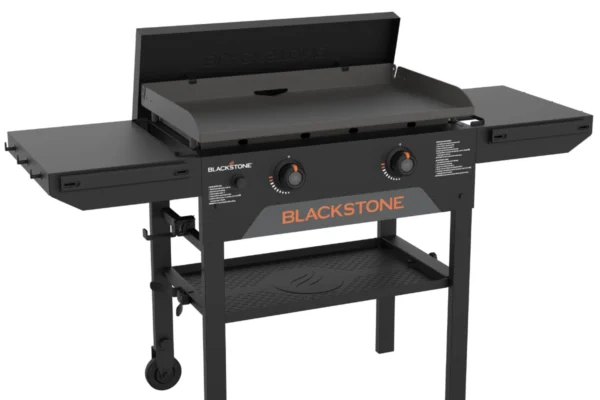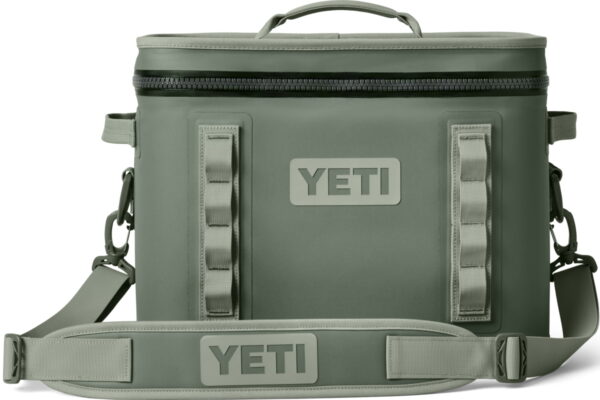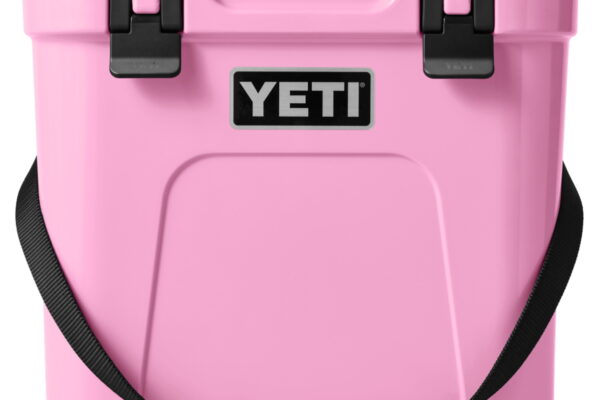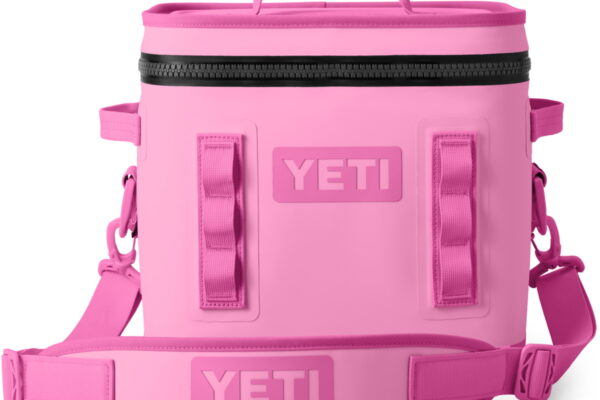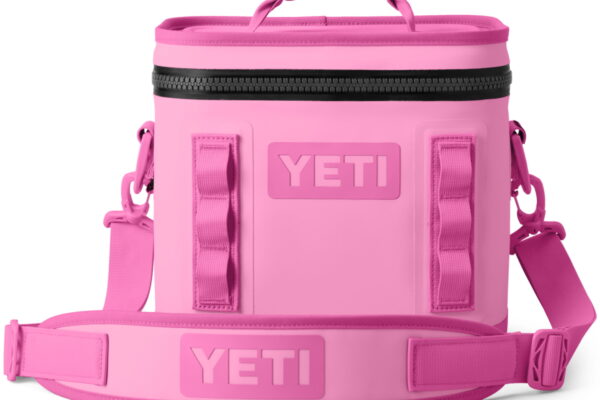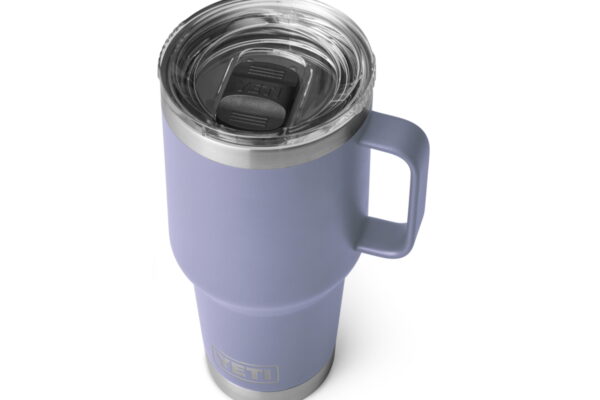The Most Delicious Big Green Egg Pork Ribs
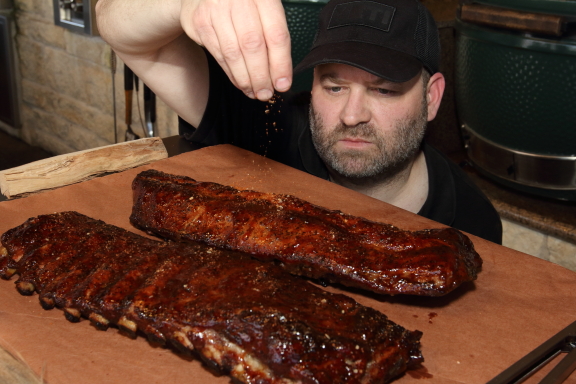
Green Egg Pork Rib Guide.
By: Kenny Martin
I consider Pork Ribs to be the 2nd piece of the BBQ triangle. From Baby Backs to a full Spare or trimmed St Louis, Pork ribs offer something for everyone, including a blank palette from which to use your creativity to apply rubs, brines and sauces. This guide will take you through the steps necessary to produce competition quality Ribs with your Big Green Egg.
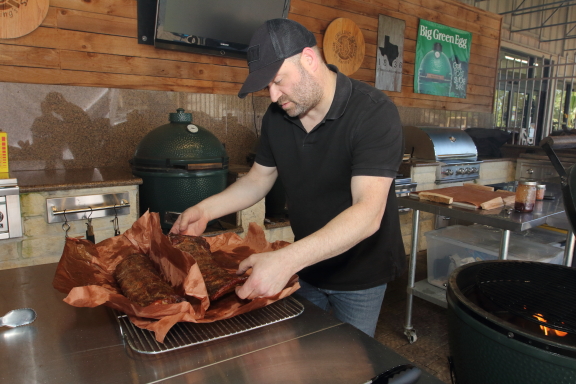
Typical Pork Rib Prep and Smoking Process (4-7 Hours)
Trim Ribs, remove membrane (Optional) -10 Minutes
Light Charcoal and build Smoke fire – 30-60 Minutes
Season Ribs-Place in Fridge while Green Egg is settling in temperature
Place Ribs on BBQ-Smoke for 2-3 hours
Wrap Ribs in Foil or Butcher Paper (optional) and place back on grill for 1 hour.
Remove Ribs from foil or Butcher Paper and place back on grill for 1 hour.
Glaze Ribs and remove from Egg.

Cooking Concepts
Slow and Steady- Temperature range is 250-275. This is the sweet spot for smoking on the Green Egg for the following reasons. The Fire and Wood are burning at a rate that allows the oxygen and Lump Charcoal to burn at a steady and efficient pace. With proper charcoal and setup, this fire will burn for up to 12 hours, sometimes longer. This is my preferred smoking method for Ribs, as it provides a nice combination of smoke and heat, while creating a nice flavor profile. Expect 4-5 Hours of Cooking time depending on the types of ribs you are cooking.
The Texas Two Step- Starting temp is 250, which develops a nice smoke profile before we increase the temperature to 300 for the last hour. Apply a simple glaze or BBQ sauce and you are ready for Rib Nirvana. When used in combination with a wrapping strategy, the Two Steps produces excellent flavor, color and texture. Expect 3-4 hours of Smoke time.
Hot and Fast –SmokingTemperature is 300. Let’s face it, you’ve decided to smoke pork ribs on the same day with little prep and time is of the essence. We will throw caution to wind here and utilize the egg’s ability as a water smoker to smoke our Ribs in 2 – 2 ½ hours. If wrapping in foil, cut your wrap time to 30 minutes.
Concept Variations – Feel free to use any combinations of temperatures and wrapping strategies to create your own BBQ experience.
Tip – Baby Back Ribs cook faster thanSt Louis and Spares.Be Prepared.
BBQ Toolkit
Smoking Wood (See guide)
Baking Sheets or Aluminum pan filled with ½ cup of water. 15”x10”x 9/16” for Xlarge, 11”x9”x 1½“for large.
Rubber Gloves
Instant read thermometer. (Thermoworks MK IV recommended).
Aluminum Foil-Heavy Duty and Regular
Butcher Paper-Food Grade, unlined or unwaxed. (Optional) 24” width.
Spray Bottle for spritzing.
Rib Rack (Optional)
Grill Extender (Optional, but recommended) Standard or Eggspander
6” Boning Knife
Basting Brush-Silicon preferred.
Temperature control system like Flame Boss or BBQ guru(Optional)
Food Saver Vacuum sealer with 11” custom bags. (Optional)
Chimney Starters (Optional). I recommend two for the xlarge, 1 for the large.
Ball Jars (Optional)
Measuring Spoons
Metal Tongs
Rib Consideration:
Spare Ribs-Cut from the belly of the hog, these ribs offer tremendous flavor and connective tissue that are perfect for our smoking concepts.
St Louis Style-A trimmed version of the spare, they are rectangular in shape, and one of the most common ribs you will find in the meat case or at your local butcher.
Baby Backs-Cut from the loin or back of the Hog, Baby Backs are known for their meaty loin tops, as much as they are for popularity with restaurants. Cook time is typically less than St louis.
Rib Tips- Cut from the top of the pork spare rib, these little nuggets require some extra care, but produce tasty little bites.
Where to buy your Ribs:
There are many choices available in terms of meat quality, Heritage breeds (Duroc, Berkshire), as well as locally sourced pork. Baby back and St Louis Style Ribs range in price from 2.00-9.00 Per lb, with Heritage Pork carrying a premium price.
- Central Market-They carry both St louis Style and Baby Back Ribs, both Natural and Berkshire Pork.
- HEB-Depending on which store is in your area, they carry everything from natural to premium pork products. Meat Quality is excellent.
- Whole Foods-They carry both Baby Backs and St Louis Style Ribs.
- Pete’s Fine Meats. They carry Heritage and natural pork ribs.
- Duke’s Premium Meats – Home Delivery and a great selection.
Rubs- My two cents on Rubs, make them from scratch. It’s fun, easy and leads to experimentation that will guide your taste buds. The base foundation of your rubs starts with Salt, Kosher to be exact., followed by equal parts coarse ground pepper. We follow up with our savory spices (Garlic Powder, Onion Powder), and finish with our sweet (Sugar) and heat (Cayenne).
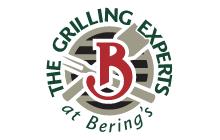
Rub Ingredients:
Kosher Salt-Large Crystals.
Pink Salt or Prague powder#1 (Curing Salt)-Optional
Coarse Ground Pepper
Garlic Powder
Onion Powder
Paprika-Smoked or Sweet.
Chili Powder-Many variations here, use anything you like. Most Chili powders are a blend of dried chilis, cumin, garlic and onion powder.
Turbinado Sugar-I like the bigger crystals, plus it has a higher smoke point.
Cayenne Pepper or anything hot works here.
Brining – I will brine Baby Back Ribs and occasionally St louis Style Ribs. Baby back ribs have the leaner part of the loin on top which can dry out very easily. St Louis Style Ribs have more connective tissue and fat.
Curing – Just like curing bacon, this simple addition helps to tenderize and add incredible texture and flavor to our ribs. I typically use this for St Louis Style Ribs.
Vacuum Sealing – One of the best ways to intensify a dry brine and seal in flavor.
Glazes –. Glazes are fun to make and provide a nice finish at the end of your smoke.
Finishing Dust – A slight sprinkle of Smoked Salt and brown sugar for a flavor pop.
Smoking wood: While there are many different types of wood you can use, I prefer to use Oak, Pecan or Hickory. Look for split pieces, sticks or chunks that will provide the necessary smoke flavor needed for a long smoke. Smoking chips work as well for the first part of your smoke and can be used in conjunction with the chunks or sticks. (About 1-3lbs of wood).
Hickory –Consistent burn and excellent flavor.
Post Oak –Consistent burn, butsometimes hard to find in Houston. Produces a very sweet mellow flavor that I really enjoy.
Red Oak –Hidden gem in my opinion. Burns slower than Post Oak, but wonderful flavor and great color.
Pecan -I love pecan, it’s my go to for Ribs and Pork.
-Let your eyes and nose be your guide when to place your Ribs on the EGG. When the smoke is white and smells pleasing to you, it’s ready.
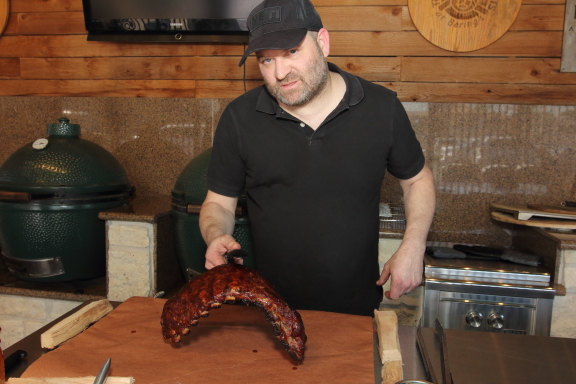
Food Prep for St Louis Style or Spare Ribs
- Remove Ribs from Packaging and rinse under cold water
- Use paper towels to pat the Ribs dry.
- Using a small knife, remove any unwanted meat or fat that looks like it shouldn’t be there.
- Remove membrane from back of the ribs. (Optional)
- Spray Ribs with White Vinegar
- Apply Salt and Pepper Mixture. Let meat sweat for 5-10 minutes.
- Apply remaining Rub ingredients all over ribs.
- If using vacuum sealing bags, place inside bags and seal.
- Place Ribs in Refrigerator for 2 hours (unsealed), up to 24hrs if vacuum sealed.
- If using Curing salt, place in refrigerator for 24-48 hours.
- 15 minutes before placing on the Egg, place ribs in Freezer if sealed.
- 15 minutes before smoking, Remove from freezer and sealed bags and place on a baking sheet or aluminum pan. Let sit for about 15 minutes.

Food Prep-Baby Back Ribs
Ingredients:
2 Racks of Baby Backs.
Rub (Spices only, no salt) if brining first.
Brining Solution:
10 Cups of Water
4 Cups of Vegetable Stock (32oz)
½ Cup of Salt (Non-Iodized)
½ cup Granulated Sugar
- Mix Water, Stock, ½ Cup Salt, ½ cup Granulated Sugar together in large container. Mix well with whisk until fully combined.
- Remove Ribs from packaging and place into water brine.
- Place Ribs in Refrigerator for 2 hours.
- Remove from Fridge and rinse ribs. Pat dry with towels and place on a cooling rack or aluminum pan meat side up.
- Spray Ribs with White Vinegar
- Apply Rub all over ribs.
- If using vacuum sealing bags, place inside bags and seal.
- Place Ribs in Refrigerator for 2 hours (unsealed), up to 24hrs if sealed.
- 15 minutes before placing on the Egg, place ribs in Freezer if sealed.
- 15 minutes before smoking, Remove from freezer and sealed bags and place on a baking sheet or aluminum pan. Let sit for about 15 minutes.
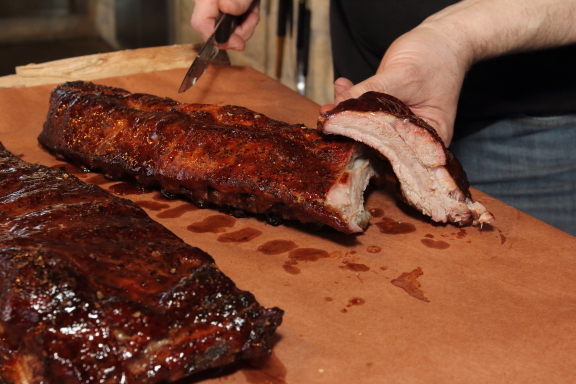
Egg Setup: Proper Setup is a must when cooking your brisket.
- Start by removing your grill and ConvEGGtor, remove any unused charcoal. (For long smokes, use fresh charcoal only).
- Remove the charcoal grate and the upper/lower rings.
- Use ash tool to remove ash that has settled on fire box.
- Use a shopvac or vacuum to remove the ash and charcoal pieces from the egg. If you have ash or dust, you can use a wet cloth to wipe off.
- With the lid open, reach underneath and wipe the Green Egg Thermometer.
- Use a piece of Aluminum foil or grill brush to clean the grill if dirty.
- Re-assemble rings and charcoal grate.
Big Green Egg as a Smoker – In order to utilize the Green Egg as a smoker, we need to understand the differences between your Green Egg and traditional Offset Smokers. The Ceramic lining in the Egg not only helps to maintain temperatures, but also helps to retain moisture (humidity) as well. In traditional offset smokers, the use of water pans is necessary to maintain moisture inside the smoker, thereby preventing the meat from drying out too quickly as convected air dries the surface of your ribs. Add a water pan full of water in your Green Egg and the added moisture prevents your meat from developing that nice bark we all love. Having said that, I find a drip pan with about ½ cup of warm water (should lightly cover the pan) is needed to gather fat drippings, which in turn provide the proper humidity inside your Egg. There are some variables depending on the desired smoking temperatures. Another consideration is the ConVeggtor itself. A cold ConVeggtor will take time to heat up, but as your Ceramics equalize temps, the heat coming from below will become greater the longer the smoke.
Building a Smoke Fire. It all starts with mastering the basics of building a smoke fire that will provide you with the knowledge necessary to smoke Meat, Seafood and poultry on your Green Egg. When it comes to smoking ribs, use fresh charcoal and save the leftover pieces for other shorter cooks. The most IMPORTANT part of smoking meat is the movement of heat, smoke and the water vapor. A stale fire with no air movement will only cook your Ribs like using an oven, but not impart that smoke flavor we desire. Smoke and its flavor particles are attracted to the imperfections that are present on the surface of the meat as well as cold and wet. We are looking for the combination of all three. The first 2-3 hours of smoking is when our Ribs will develop the majority of the smoke flavor profile we are looking for.
- Optimize – Build a foundation fire that will provide the fuel necessary to maintain desired smoking temperatures.
- Equalize – Allow the internal ceramics and ConvEGGTOR to reach an equalized temp, thereby maximizing airflow and heat movement.
- Flavorize – The depositing of good smoke on the meat surface.

Fire Setup:
- Fill Egg with enough charcoal to build a pyramid shape leaving the outer parts of the grate holes open
- With Vents wide open on Bottom and Top, light fire with your charcoal starters or heating element. After about 10 minutes, use your ash tool to stir the charcoal around the bottom of your grate. This will help the fire spread quicker.
- Add Smoking Sticks or Chunks on top of first layer.
- Add more charcoal to the top of the first ring.
- Place Plate Setter (Legs Up) for indirect cooking with one leg directly in the back of the egg.
- Place Aluminum Pan with about ½ to 1 cup of water on top of plate setter (this will be used to keep the meat from drying out)
- Place Grill on plate setter.
- Let Fire start to light the new charcoal as well as your chunks, about 10-15 minutes. Egg should be smoking at this point.
- Close Lid and leave vents open until you reach your desired temperature.
- Open the egg and place the Ribs meat side up for two ribs or staggered in the rib rack, exposed bone side down.
- Close the lid and continue smoking the Ribs at your desired temperature.
- After about 1 ½ hours, take a look at your ribs and if they are dry on the outside, spritz them. Check to see if you have water in the drip pan and if dry, add about ½ cup.
- Continue smoking the ribs for another hour, spritzing every 30 minutes.
- Use and instant read thermometer and insert in between the bones to check your temperature. When your temp registers 165-170 degrees, we can wrap our ribs with Aluminum foil or butcher paper. (Optional)
- If you are choosing not to wrap your ribs, continue smoking your ribs and spritz every 30 minutes or as needed.
- When your ribs are at 190-195, you can apply your glaze, then re-apply another coat after 10 minutes.
- When estimating doneness, refer to the guide below.
Humidity, Water and Drip Pans: While traditional Offset smokers use both a drip and water pan, we can utilize both by using a disposable 15”x10”x 9/16” for Xlarge, 11”x9”x 1 ½ “for large baking sheet. While Water ratios can vary from pit to pit, less is actually more with Kamado style smokers. This is attributed to the ceramic lining and sealed environment that helps to maintain moisture (Humidity) inside the Egg. Add to much water and your Ribs will never develop enough bark as the surface remains moist throughout. Add too little and the airflow and lower moisture can dry out the surface of your Ribs. Temperature also plays a role here, higher Smoking temps will evaporate water quicker than lower temps. A good rule of thumb here is as follows.
(½ cup boiling water for 250 degrees, 1 cup for 275-300 degrees)
Spritzing: After 2 hours of smoking, we want to take a peek and see how the surface of our Ribs are developing its bark and flavor profile. If you notice that its drying out to quickly, then I would spritz with water in order to gauge if I need to add more water to my drip pan.
Remote Monitoring/Instant Read Thermometers.
An instant read Meat thermometer will aid you in getting accurate readings from your Ribs. However, when smoking ribs, the surefire way to determine doneness boils down to feel. Instant read thermometers can give you a pretty good idea of where you are at during a smoke, but there are easy ways to determine if your ribs are done that involve some very easy to test parameters.
Wrapping:
The main reason to wrap your Ribs is to help your meat retain moisture, while speeding up the cooking process. The main difference between the wrapping methods has to do with texture and personal preference. Ribs that haven’t been wrapped are tender but have some chew to it. Aluminum foil is at the top of the list for tenderness with less chew, not to mention braising the ribs as well.
No Wrap: This method will work for slow and steady or hot and fast.The reason this works is due to the Egg’s ability to function like a convection oven and water smoker. Make sure to keep an eye on your water pan and fill as needed. You will need all the moisture you can get to keep the ribs from drying out too quickly. Additionally, you will need to start spraying your Ribs with and water/cider solution after a couple of hours on the Egg.
Aluminum Foil: If done correctly, your ribs will have a moist center with a nice exterior bark, if wrapped to long, your ribs will be very mushy. The trick to wrapping with foil is to wrap your ribs very tight. After 30 minutes in aluminum foil, I remove my ribs and place them back on the BBQ. Save the juice to make your serving sauce.
Butcher Paper: Same concept as Aluminum Foil, however the texture falls somewhere between unwrapped and Aluminum Foil.
How do you know when your Ribs are Done: An Instant read thermometer should be your first option, followed by feel. St Louis style ribs can be held in the middle of the rack, and if they droop over and crack freely, they are typically done. Baby Back Ribs can be a little trickier since the loin on top will keep the ribs from flexing. Finished temps should be anywhere between 197-203.
Serving: Ribs are very easy to serve and only require a knife to cut down the center of the meat in between the bones. Let the ribs rest about 10-15 minutes before serving or wrap in butcher paper and place in a cooler to enjoy later.
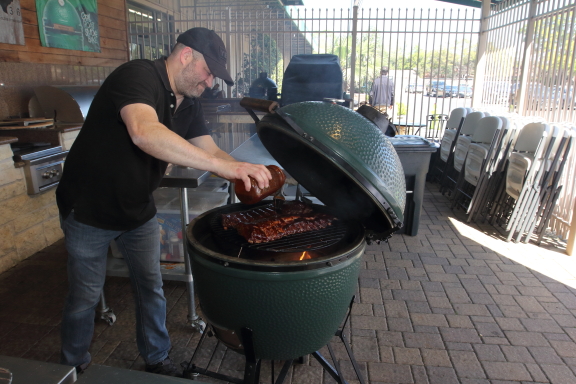
BBQ Mop Sauce
1 Cup White Wine Vinegar
1 Cup Apple Cider Vinegar
1 Cup Ketchup
1 Teaspoon Valentina
½ teaspoon light brown sugar
¼ teaspoon Ground pepper
1 teaspoon salt
Food Prep:
- Combine all ingredients in a large bowl.
- Mix together with a whisk
BBQ Sauce
28 Oz Can Tomato Puree
1 Cup Ketchup
1 Teaspoon Worcestershire sauce
2 Tablespoons Brown Sugar
½ Cup Apple Cider Vinegar
¼ Teaspoon Paprika
¼ Teaspoon Chili Powder
½ Yellow Onion Diced
2 Garlic Cloves-Minced
Tablespoon Unsalted Butter or neutral oil (canola, Vegetable)
Salt
Pepper
12 Ounces of your favorite soda (Dr Pepper, Dublin Cola or Root Beer).
Food Prep:
- Combine first 7 ingredients in a large bowl.
- Mix together with a whisk
- Add Soda and wait until foam subsides.
- Whisk together lightly.
- In a 2 Quart Pot, heat oil or butter over medium heat.
- Add Onions and garlic.
- Cook for a few minutes then lower heat to low
- When Onion becomes translucent add wet mixture
- Stir together and increase heat to medium high.
- When mixture starts to boil, lower to simmer
- Cook 25-30 minutes until sauce thickens. Stir Occasionally
- Remove from heat and let cool.
BBQ Glaze.
Ingredients:
½ Cup Apple Cider Vinegar
½ Cup Ketchup.
½ Cup Light Brown Sugar
½ Cup Honey
1 Teaspoon Cornstarch
1 Tablespoon of your favorite rub
Food Prep:
- Whisk together all ingredients in a saucepan under medium low heat.
- Continue cooking for 5-7 minutes, whisking occasionally.
- Remove from heat and let cool to room temperature
Tips:
Line your Conveggtor with aluminum foil if applying sauce and glazes. This will keep your Conveggtor clean and free of grease smoke.
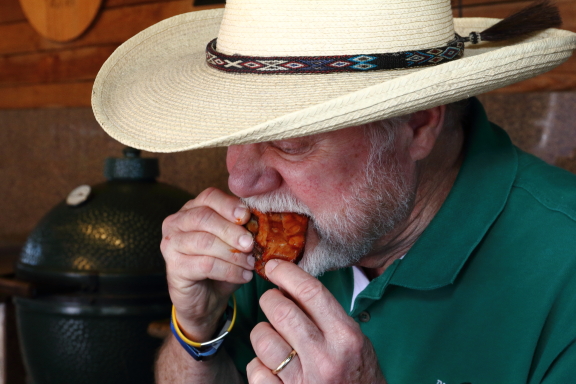
Lastly, Ribs are a lesson of patience, timing and execution. Master the process and you will be enjoying your own competition quality Ribs, not mention making a lot of friends and family very happy people.
Enjoy!
